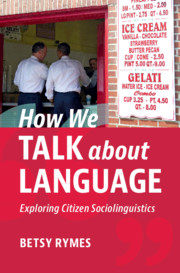Book contents
- How We Talk about Language
- How We Talk about Language
- Copyright page
- Contents
- Figures
- Tables
- Preface
- Introduction
- 1 Citizen’s Arrest!
- 2 Wonderment
- 3 Doing Citizen Sociolinguistics
- 4 Fomenting Wonderment and Critique
- 5 Citizen Sociolinguistics and Narrative
- 6 Acts of Citizen Sociolinguistics
- Conclusion
- References
- Index
5 - Citizen Sociolinguistics and Narrative
Published online by Cambridge University Press: 07 September 2020
- How We Talk about Language
- How We Talk about Language
- Copyright page
- Contents
- Figures
- Tables
- Preface
- Introduction
- 1 Citizen’s Arrest!
- 2 Wonderment
- 3 Doing Citizen Sociolinguistics
- 4 Fomenting Wonderment and Critique
- 5 Citizen Sociolinguistics and Narrative
- 6 Acts of Citizen Sociolinguistics
- Conclusion
- References
- Index
Summary
Citizen sociolinguists inevitably tell stories that contextualize their own language use, drawing on personal narrative to talk about language and convey how language works in their lives. Often, these personal anecdotes lend a democratic quality to citizen sociolinguistic expertise, drawing in an audience from varied backgrounds. This chapter focuses more explicitly on the affordances of the narrative genre for citizen sociolinguistics, exploring the kinds of stories people tell about their language use, and how narrative logic informs the conclusions of those storytellers as well as the responses from their audience. I focus on the narratives that most YouTube “accent challenge” videos include as introductory material, as well as the response narratives that appear in the comments underneath those videos. These data illustrate how narrative builds affinity spaces for highly localized communicative practices, and in the process constructs an emergent sociolinguistic validity to the language claims being expounded.
- Type
- Chapter
- Information
- How We Talk about LanguageExploring Citizen Sociolinguistics, pp. 150 - 169Publisher: Cambridge University PressPrint publication year: 2020

